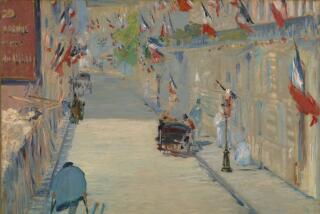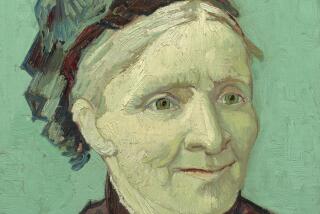A Detached and Dreamy Survey of Villon
- Share via
At Louis Stern Fine Arts, approximately 40 small- to medium-sized canvases by Jacques Villon (1875-1963) reveal that the French painter was in love with the idea of being an artist. Unlike Marcel Duchamp, his more famous brother who was in love with the social trappings that went along with an avant-garde artist’s reputation, Villon seems to have savored quiet afternoons in the studio, patiently calibrating his compositions and colors so that every little picture came out just right.
Spanning 60 years, the weirdly colored but often fussy works that make up this substantial survey are both detached and dreamy. Too sensible to buy into the cliche that artists are rebellious romantics, yet unwilling to abandon art’s possibilities, Villon’s painstaking oeuvre has the presence of a cautious retreat from the hustle and bustle of everyday life.
Never quite Arcadian, neither are his paintings disruptive. Across their carefully brushed surfaces, where paint is doled out as parsimoniously as if it came from the artist’s last tube, the conservatism of highbrow tastefulness meets a staid version of individual eccentricity.
All of Villon’s paintings borrow freely from Cubism, Fauvism, Pointillism and Impressionism, without improvising within, or moving beyond, any of these modern styles. It is as if the painter thought of such precedent-abolishing movements as classical endeavors--solid foundations whose gestures and vocabularies could be standardized, extrapolated upon and repeated, over and over again.
Within such an academic outlook, Villon found sufficient room to maneuver. In the 1930s and ‘40s, he made his best paintings--compact little pictures that are both dense and ethereal.
Such works as “L’Ocean” (1932), “Saut perilleux” (1943), “La Mort d’Io” (1944), “Le Minotaure” (1944) and “La Buste” (1949) still look fresh and strange, and they could have been painted very recently. Depicting nothing in particular, they marry specificity to open-endedness with unexpected aplomb.
In the 1950s and ‘60s, however, the dreamy, far-off quality of Villon’s paintings gave way to a sense of mere unfinishedness. Rich colors went cold, compositions got static, and abstract arrangements became brittle, as if the elasticity that had animated previous paintings had frozen. Nevertheless, Villon’s modest art manages to capture a curious tension between caution and risk.
* Louis Stern Fine Arts, 9002 Melrose Ave., (310) 276-0147, through Sept. 6. Closed Sundays and Mondays.
More to Read
The biggest entertainment stories
Get our big stories about Hollywood, film, television, music, arts, culture and more right in your inbox as soon as they publish.
You may occasionally receive promotional content from the Los Angeles Times.










